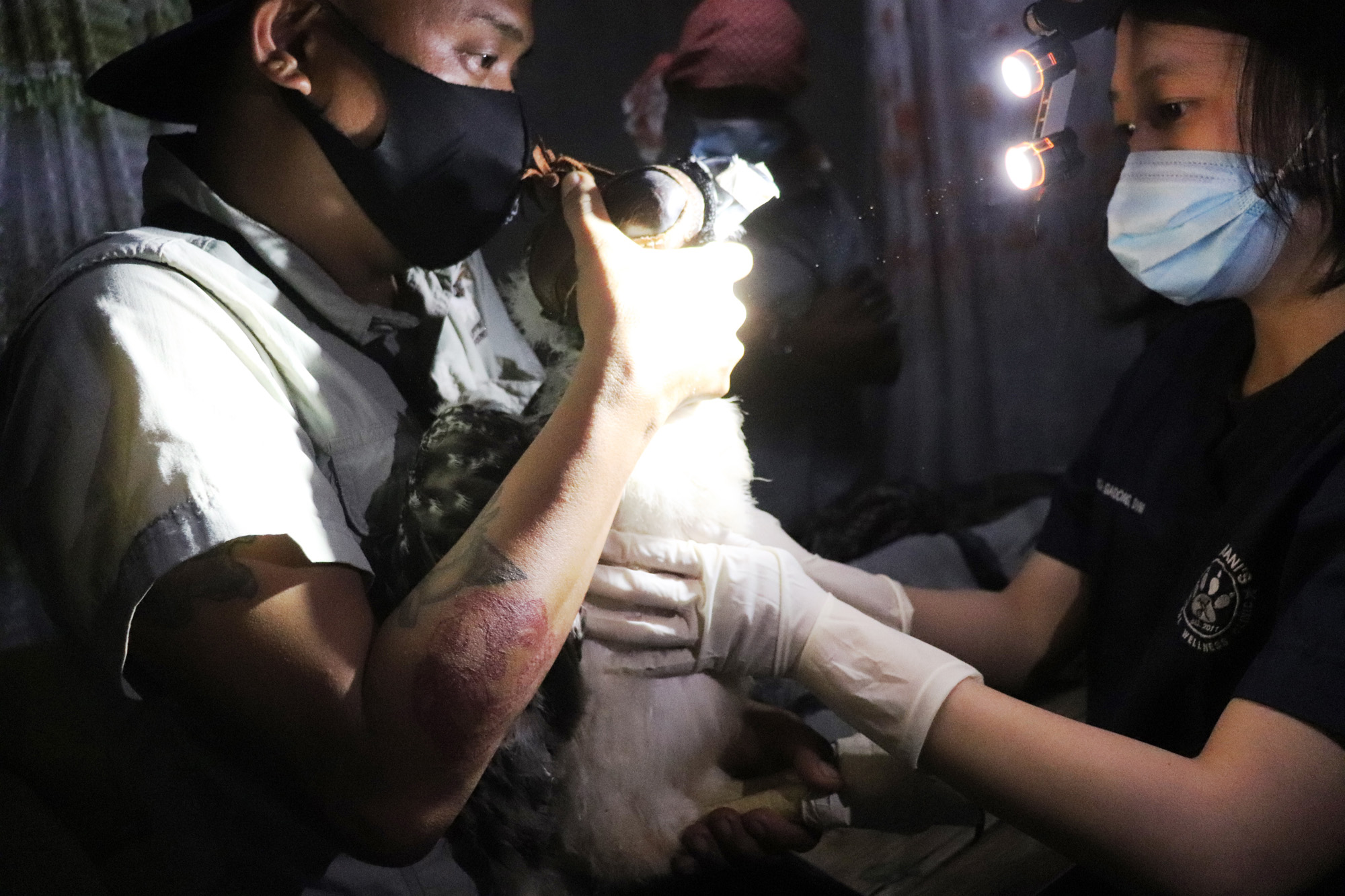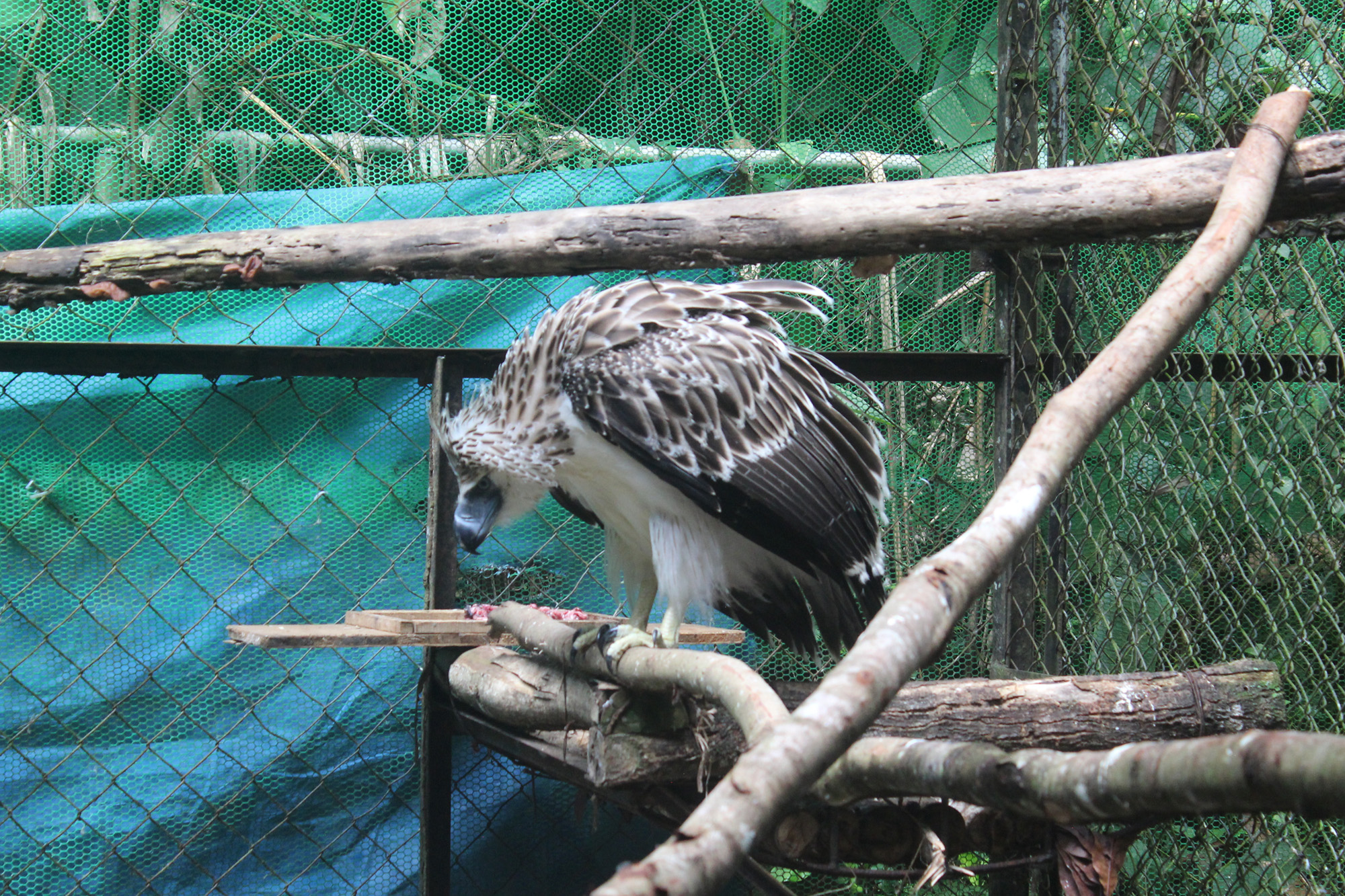DAVAO CITY (MindaNews / 09 June) – COVID-19 has not stopped people from hunting Philippine Eagles (Pithecophaga jefferyi), a bird listed as “critically endangered” by the International Union for Conservation of Nature, three of them admitted for treatment at the Philippine Eagle Center (PEC) in Davao City in the first quarter of 2021.
It was a series of eagle rescues, with each bird representing a different age group. One is a sexually immature bird (three to four years old) rescued in January. One is a very delicate juvenile (two-month-old chick) that was admitted in February. And the third is a sexually mature, adult bird (over five years old) in March. Here are their tales.
Shooting survivor
The local government of Maitum reported a captive eagle to the Philippine Eagle Foundation (PEF) and the Department of Environment and Natural Resources (DENR) on January 9. The bird was rescued by locals at Mt. Busa after they saw the weak bird entangled among forest vines. The bird was named Salagbanog (or “eagle’s nest”), after the waterfalls at the capture site.
CENRO Kiamba, the DENR’s closest field station, responded. In no time the male eagle was restrained and safely transported. At the border of Sarangani Province and Davao del Sur, CENRO staff Edgar Calderon handed the bird over to the PEF rescue team, who then brought it to the PEC for examination and rehabilitation.
The adolescent bird was a shooting survivor. X-ray showed a 16 mm round object lodged between the skin and the muscles on its right shoulder. The object was a toy marble, which is used as a projectile in hunting rifles locally called “Jolen” or “Marble” guns. The PEF removed the marble through surgery.
Salagbanog is the second eagle shot with a marble gun during the pandemic. The first bird was eagle “Balikatan,” another immature eagle rescued in Surigao del Norte in August last year. Miraculously, the bird had no wound and was merely stunned. It fell off from its perch after getting hit by the marble.
A marble gun is an improvised firearm that shoots marbles through gas pressure from denatured alcohol combustion. Although illegal, it has become a very popular hunting rifle across the country.
X-ray also showed an air gun pellet trapped at the base of the bird’s neck. No entry wound was visible for the marble and the pellet, which suggests that the shootings happened a few months back.
 Philippine Eagle Salagbanog’s x-ray shows the marble circled in red. MindaNews photo courtesy of Philippine Eagle Foundation
Philippine Eagle Salagbanog’s x-ray shows the marble circled in red. MindaNews photo courtesy of Philippine Eagle Foundation
Shooting remains a big threat to our national bird. For example, of the 89 eagles admitted for care and rehabilitation at two PEF rescue facilities since the 1970’s, 23 (26 %) were birds that had gunshot wounds. Of these birds, seven died within a few months after admission.
The pandemic did not stop the hunting. It might have even fueled it. X-rays of three eagles rescued during COVID-19, including eagle Salagbanog, showed air gun pellets inside their bodies.
Many Filipinos admire the Philippine eagle as a majestic national symbol. But sadly, some Filipinos still treat them as mere game in a wildlife hunt.
Saving a baby eagle
On February 24, a local farmer climbed an eagle nest tree in Bukidnon and removed a two-month-old chick from the nest. Two days later, a community leader contacted PEF.
Responding instantly to the call, PEF, CENRO Valencia, and LGU San Fernando personnel rushed to the bird’s rescue. They arrived close to midnight of February 26 at a remote village in San Fernando town where the chick was kept. The chick was named Agsamon, after the mountain where the nest is found.
PEF Vet Consultant Sheen Gadong examined chick Agsamon and injected fluids and food supplements. With the tender age and fragile state of the bird, first aid saved its life.
After stabilizing the bird, we negotiated the chick’s release.
 Rescuers check the heart rate and other vital signs of Philippine Eagle Agsamon upon arrival at a remote community in San Fernando, Bukidnon. MindaNews photo courtesy of Philippine Eagle Foundation
Rescuers check the heart rate and other vital signs of Philippine Eagle Agsamon upon arrival at a remote community in San Fernando, Bukidnon. MindaNews photo courtesy of Philippine Eagle Foundation
The farmer believed he would be rewarded once he gives the bird to the government. His relatives also argued that if the bird is really that valuable, it should not be hard for the government to pay. This is the seventh case of a chick stolen from its nest since the program began on Mindanao four decades ago. In all of these cases, the captors expected a cash reward.
We explained patiently that protection does not mean giving rewards for eagle captures, but it meant keeping the bird free and unharmed in the wild. We also gave examples of community-based conservation to demonstrate how locals can participate in and benefit from conservation.
It took the captor and his supporters some time to accept the sense of the country’s law and program for the Philippine Eagle. Clearly, the remoteness of the area means its residents are way outside the influence of mainstream perspectives and values.
Our experience was a classic case of a mismatch of standards. While we see eagles and other unique wildlife as worth preserving, some remote villagers might think differently.
With poor access to formal education and limited understanding of wildlife laws, the captor and perhaps his village members too hold a purely utilitarian value for the eagles and other wildlife. While many urban residents revere or treasure the eagles, the same animal to upland dwellers could be just food or a novelty item that can be traded for cash.
Adequate conservation education and awareness campaigns can bridge this value gap. When combined with community-based engagements that bring a better life to poor families, utilitarian attitudes can be transformed to genuine care and concern for the species.
After over two hours of negotiation, we agreed to explore a partnership and protect the eagle couple at Mt Agsamon. With chick Agsamon gone from the nest, the eagle couple will re-nest this year. As long as the forest is intact and the eagle pair is not harmed, it will re-nest in the same area for years, just like how generations of eagle pairs in the past have nested in the same place over and over again. Eagle breeding places are ancient nesting sites. As centers of reproduction, protecting these sites secures the species.
The team left with chick “Agsamon” before dawn. The next weekend, we were back and held a pact with the community through a traditional ritual. We also launched a livelihood project for the women as a pilot conservation incentive. Through fair community engagements, we hope that future eaglets from Agsamon’s parents will be spared from the same ordeal their sibling has experienced.
 Philippine Eagle Agsamon turns five months old in May 2021. MindaNews photo courtesy of Philippine Eagle Foundation
Philippine Eagle Agsamon turns five months old in May 2021. MindaNews photo courtesy of Philippine Eagle Foundation
A good eagle is a trapped eagle
Another male eagle was accidentally caught in a native trap in the forests between Lingig and Boston towns in Surigao del Sur last March. The poor bird was due to be butchered and cooked when Richard Mahomoc, a passerby, saved it by buying it for Php 5,000.00 (US $ 100.00). This is the first adult bird rescued during the pandemic period.
Mahomoc caged the bird for four days and fed it with pork and fish. He named the eagle Rajah Cabongsuan, after the community near the trap site. Finally, he contacted Gilbert Dragas of CENRO Bislig City, who then alerted the PEF. On March 23, the PEF retrieved the eagle in Bislig City and brought it to the PEC for rehabilitation.
Eagle Rajah Cabongsuan is the fourth eagle captured in a native trap during the pandemic period. Based on PEC admission records, he is the twelfth eagle accidentally caught by local traps intended for other wildlife (deer, wild pig, palm civet, monkey, etc.).
Philippine Eagles walk on the ground to hunt monitor lizards, snakes, rats, and a few more mammals. This behavior of exploring the forest floor for prey makes them vulnerable to improvised noose traps.
Three birds were also intentionally trapped by farmers whose domestic animals the eagles have killed. In one of these cases, the eagle hunted and ate a dog. To get back at the bird, the pet owner used the dog’s remains as bait and trapped and caught the bird. He attempted to sell it but the barangay leaders knew it was protected and confiscated the bird. The PEF rehabilitated and released this eagle back to the forest in 2010.
During the pandemic, two eagles were also purposely trapped by farmers after the eagles killed and ate their piglets. Overall, trapping accounted for 15 admission cases (17 %) at the PEC since the 1970’s. For poor farmers whose livestock were lost to the eagles, the only good eagle is a trapped eagle.
Don’t harm me
These stories of eagle rescues prove that some people can still harm the remaining wild population of our national symbol in the wild. If we look further at the PEF’s 89 cases of eagle admission cases at the PEC, a total of 53 birds or 60 % were due to human persecution (shooting, trapping, clubbing, chick removal from the nest, and selling).
The pandemic, and its economic impacts in the uplands seemed to have made the eagles even more vulnerable to human harm. Since the COVID-19 quarantines and lockdowns that began in March 2020, a total of 10 Philippine eagles were rescued on Mindanao Island alone. This is five times the pre-COVID average annual rescue rate. It is also the highest rescue rate ever in the program’s history.
June 4-10 of each year is being celebrated as the national “Philippine Eagle Week.” This nationwide campaign is now on its 23rd year. If a Philippine eagle can talk and deliver a message to the public, perhaps its simple plea would be “Please stop harming me and my family.”
(Jayson C. Ibañez is the Director of Research and Conservation at the Philippine Eagle Foundation. He is also a Senior Lecturer at the University of the Philippines in Mindanao.)
